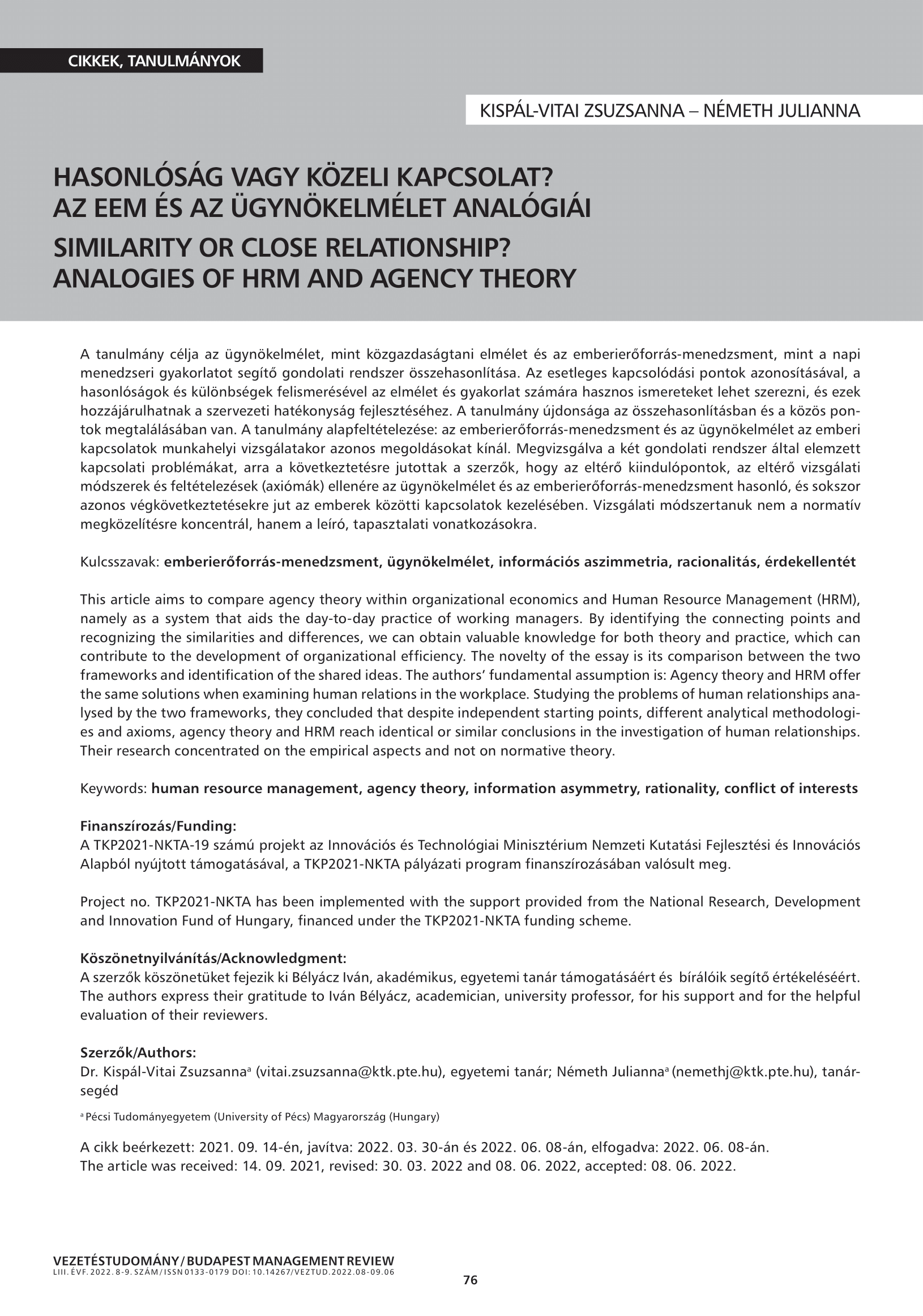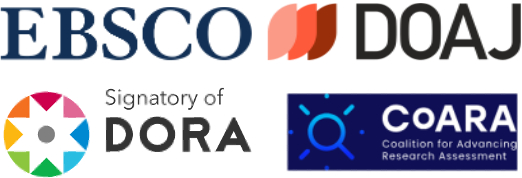Hasonlóság, vagy közeli kapcsolat? Az EEM és az ügynökelmélet analógiái
DOI:
https://doi.org/10.14267/VEZTUD.2022.08-09.06Kulcsszavak:
emberierőforrás-menedzsment, ügynökelmélet, információs aszimmetria, racionalitás, érdekellentétAbsztrakt
A tanulmány célja az ügynökelmélet, mint közgazdaságtani elmélet és az emberierőforrás-menedzsment, mint a napi menedzseri gyakorlatot segítő gondolati rendszer összehasonlítása. Az esetleges kapcsolódási pontok azonosításával, a hasonlóságok és különbségek felismerésével az elmélet és gyakorlat számára hasznos ismereteket lehet szerezni, és ezek hozzájárulhatnak a szervezeti hatékonyság fejlesztéséhez. A tanulmány újdonsága az összehasonlításban és a közös pontok megtalálásában van. A tanulmány alapfeltételezése: az emberierőforrás-menedzsment és az ügynökelmélet az emberi kapcsolatok munkahelyi vizsgálatakor azonos megoldásokat kínál. Megvizsgálva a két gondolati rendszer által elemzett kapcsolati problémákat, arra a következtetésre jutottak a szerzők, hogy az eltérő kiindulópontok, az eltérő vizsgálati módszerek és feltételezések (axiómák) ellenére az ügynökelmélet és az emberierőforrás-menedzsment hasonló, és sokszor azonos végkövetkeztetésekre jut az emberek közötti kapcsolatok kezelésében. Vizsgálati módszertanuk nem a normatív megközelítésre koncentrál, hanem a leíró, tapasztalati vonatkozásokra.
Letöltések
Hivatkozások
Allen, D.W. & Lueck, D. (1999). Searching for Ratchet Effects in Agricultural Contracts. Journal of Agricultural and Resource Economics, 24(2), 536-552. https://www.jstor.org/stable/40987037
Appelbaum, E., Bailey, T., Berg, P. & Kalleberg, A.L. (2000). Manufacturing Advantage: Why High-performance Work Systems Pay off. Ithaca, NY: Cornell University Press.
Armstrong, M. (2006a). A handbook of Human Resource Management Practice (10. ed). London: Kogan Page.
Armstrong, M. (2006b). Strategic Human Resource Management – A guide to action (6. ed). London: Kogan Page.
Arrow, K. (1985). The Economics of Agency. In Pratt, J.W. & Zeckhauser, R.J. (Eds.), Principals and Agents: The Structure of Business (pp. 37-55). Boston: Harvard Business School Press
Balogh, G., Poór, J., Vinogradov, Sz., Illés, B. Cs., & Tóth, K. (2018). Személyzetfejlesztés. In Poór, J., Karoliny, M., Kovács, I. É., & Illés, B. Cs. (Eds.), A HR gyakorlata: Hasonló és eltérő jellemzők az emberi erőforrás-menedzsment globális, regionális és hazai gyakorlatának alakulásában (pp. 219-287). Budapest: Wolters Kluwer.
Beer, M., Spector, B. A., Lawrence, P. R., Mills, D. Q., & Walton, R. E. (1984). Managing human assets. New York: Simon and Schuster.
Bélyácz, I. (2017). Túlélő kiúttalanságok a vállalatirányításban. Köz-Gazdaság, 12(2), 249-267.
Boxall, P. F. & Purcell, J. (2011). Strategy and Human Resource Management (3. ed). Basingstoke: Palgrave Macmillan.
Boxall, P. F., Purcell, J., & Wright, P. (2007). Human Resource Management, Scope, Analysis and Singnificance. In The Oxford Handbook of Human Resource Management (pp. 1-17). Oxford: Oxford University Press. https://doi.org/10.1093/oxfordhb/9780199547029.003.0001
Brewster, C. (2007). A European perspective on HRM. European Journal of International Management, 1(3), 239-259. http://www.itol.org/wp-content/uploads/2014/06/A-European-perspective-on-HRM.pdf
Cappelli, P. & Tavis, A. (2016). The Performance Management Revolution. Harvard Business Review, (10). https://hbr.org/2016/10/the-performance-management-revolution
Cardella, E. & Depew, B. (2018). Output restriction and the ratchet effect: Evidence from a real effort work task. Games and Economic Behavior, 107, 182-192. https://doi.org/10.1016/j.geb.2017.11.005
Chikán, A. (2020). Vállalatgazdaságtan [Digitális kiadás]. Budapest: Akadémiai Kiadó. https://doi.org/10.1556/9789634545897
Cowsgill, R. & Grint, K. (2008). Leadership, task and relationship: Orpheus, Prometheus and Janus. Human Resource Management Journal, 18, 188–195. https://doi.org/10.1111/j.1748-8583.2007.00065.x
Dessler, G. & Chhinzer, N. (2017). Human Resources Management in Canada. Toronto: Pearson. Eisenhardt, K. M. (1989). Agency Theory: An Assessment and Review. The Academy of Management Review, 14(1), 57-74. https://doi.org/10.5465/amr.1989.4279003
Fombrun, C. J., Tichy, M. M., & Devanna M. A. (1984). Strategic Human Resource Management. New York: John Wiley.
Foss, N. J. (2001). Bounded Rationality in the Economics of Organization: Present Use and (Some) Future Possibilities. Journal of Management and Governance, 5, 401-425. https://doi.org/10.1023/A:1014007330294
Foss, N. J. (2007). Agency Theory in Management [online]. https://organizationsandmarkets.com/2007/08/17/agency-theory-in-management/
Gibbons, R. & Roberts, J. (2015). Organizational Economics. In Scott, R. A. & Buchmann, M.C. (Eds.), Emerging Trends in the Social and Behavioral Sciences. Chichester: John Wiley and Sons. https://doi.org/10.1002/9781118900772
Gooderham, P. & Nordhaug, O. (2010). One European model of HRM? Cranet empirical contributions. Human Resource Management Review, 21(1), 24-36. https://doi.org/10.1016/j.hrmr.2010.09.009
Grimshaw, D. & Rubery, J. (2007). Economics and HRM. In Boxall, P., Purcell, J. & Wright, P. (Eds.), The Oxford Handbook of Human Resource Management (pp. 68-87). Oxford: Oxford University Press.
Guest, D. E. & Convay, N. (2002). Communicating the psychological contract: an employer perspective. Human Resource Management Journal, 12(2), 22-38. https://doi.org/10.1111/j.1748-8583.2002.tb00062.x
Holmstrom, B. & Milgrom, P. (1987). Aggregation and Linearity in the Provision of Intertemporal Incentives. Econometrica, 55(2), 303-328. https://doi.org/10.2307/1913238
Jensen, M. C. & Meckling, W. H. (1976). Theory of the Firm: Managerial Behavior, Agency Costs and Ownership Structure. Journal of Financial Economics 3(4), 305-360. https://doi.org/10.1016/0304-405X(76)90026-X
Jensen, M. C. & Smith, C. W. Jr. (1985). Stockholder, Manager and Creditor Interests, Applications of Agency Theory. In Altman E. & Subrahmanyam, M. (Eds.), Recent Advances in Corporate Finance. Boston: Dow-Jones Irwin. https://www.researchgate.net/publication/228138310_Stockholder_Manager_and_Creditor_Interests_Applications_of_Agency_Theory
Jensen, M. C. (1983). Organization Theory and Methodology. The Accounting Review 58(2), 319 – 339. http://dx.doi.org/10.2139/ssrn.94036
Jurkowski, S. (2017). Electronic Surveillance, Legal Information Institute. https://www.law.cornell.edu/wex/electronic_surveillance
Kahneman, D. (2011). Thinking Fast and Slow. Farrar. New York: Straus and Giroux.
Kaufman, B. E. (2004). Toward an Integrative Theory of Human Resource Management. In B. E. Kaufman (Eds.), Theoretical Perspectives on Work and the Employment Relationship. Ithaca, NY: Cornell University Press.
Kieser, A. & Ebers, M. (2006). Organisationstheorien (6. ed). Stuttgart: W. Kohlhammer GmbH.
Kieser, A. (1995). Szervezetelméletek. Budapest: Aula Kiadó.
Kim, J. & Mahoney, J. T. (2005). Property Rights Theory, Transaction Costs Theory, and Agency Theory: An Organizational Economics Approach to Strategic Management. Managerial and Decision Economics, 26, 223-242. https://doi.org/10.1002/mde.1218
Klein, P. (1998). New Institutional Economics. http://dx.doi.org/10.2139/ssrn.115811
Krullaars, T. & Visbeen, J. (2015). The changing performance management paradigm: evolution or revolution? https://www.pwc.nl/nl/assets/documents/pwc-performance-survey-2015.pdf
Lawson, P. (1995). Performance management: an overview. In The Performance Management Handbook. London: Institute of Personnel and Development. Linder, S. & Foss, N. J. (2013). Agency Theory. SMG Working paper 2013(7). http://ssrn.com/abstract=2255895
Mathis, R. L., Jackson, J. H., & Valentine, S. R. (2014). Human Resource Management (14. ed). Stamford: CENGAGE Learning.
Metz, R. (2018). This company embeds microchips in its employees, and they love it. MIT Technology Review. https://www.technologyreview.com/s/611884/thiscompany-embeds-microchips-in-its-employees-andthey-love-it/
Mintzberg, H. (2005). Developing Theory about the Development of Theory. In Smith K.G. & Hitt, M.A. (Eds.), Great Minds In Management: The Process of Theory Development. New York: Oxford University Press.
Mohan, P. (2019). These are the worst scandals of the past decade. Fast Company. https://www.fastcompany.com/90444328/these-are-the-worst-scandals-of-thelast-decade
Muratbekova-Touron, M. & Galindo, G. (2018). Leveraging psychological contracts as an HR strategy: The case of software developers. European Management Journal, 36(6), 717-726. https://doi.org/10.1016/j.emj.2018.01.001
Pepper, A. & Gore, J. (2015). Behavioral agency theory: new foundations for theorizing about executive compensation. Journal of Management, 41(4), 1045-1068. https://doi.org/10.1177/0149206312461054
Perrow, S. (1968). Economic Theories of Organization. Theory and Society, 15(1-2). 11-45. https://doi.org/10.1007/BF00156926
Poór, J., Sipos, N., Szeiner, Zs., & Kovács, I. É. (2018). Ösztönzés és juttatások – javadalmazás. In Poór, J. Karoliny, M. Kovács, I. É. & Illés, B. Cs. (Eds.), A HR gyakorlata: Hasonló és eltérő jellemzők az emberi erőforrás-menedzsment globális, regionális és hazai gyakorlatának alakulásában (pp. 289-320). Budapest: Wolters Kluwer.
Pratt, J. W. & Zeckhauser, R. J. (1958). Principals and Agents: An Overwiev. In Pratt, J. W. & Zeckhauser, R. J (Eds.), Principals and Agents: The Structure of Business (pp. 1-35). Boston: Harvard Business School Press.
Purcell, J. (1999). Best practice or best fit: chimera or cul-desac. Human Resource Management Journal, 9(3), 26–41. https://doi.org/10.1111/j.1748-8583.1999.tb00201.x
Reilley, A. P. (2007). The changing HR function. London: Chartered Institute of Personnel and Development.
Robbins, S. P. & Barnwell, N. (2006). Organisation Theory: Concepts and cases (5. ed). Harlow: Pearson Education.
Robbins, S. P. & Judge T. (2013). Organizational behavior (15. ed). Boston: Pearson.
Roberts, J. (2010). Designing incentives in organizations. Journal of Institutional Economics, 6, 125-132. https://doi.org/10.1017/S1744137409990221
Segal, T. (2018). Enron Scandal: The Fall of a Wall Street Darling. https://www.investopedia.com/updates/enron-scandal-summary/
Szabó-Bálint, B. (2018). A munkavállalói siker és az elérését támogató szervezeti karriermenedzsment-eszközök. Vezetéstudomány, 49(10-11), 85-92. https://doi.org/10.14267/VEZTUD.2018.10.08
Torrington, D., Hall, L., & Taylor, S. (2005). Human Resource Management (6. ed). Harlow: Pearson.
Torrington, D., Hall, L., & Taylor, S. (2014). Human Resource Management (9. ed), Harlow: Pearson.
Tosi, H., Werner, S., Katz, J., & Gomez-Mejia, L. (2000). How much does performance matter? A meta-analysis of CEO pay studies. Journal of Management, 26, 301- 339. http://dx.doi.org/10.1177/014920630002600207
Toyota (2019). Toyota Production System. https://www. toyota-europe.com/world-of-toyota/this-is-toyota/toyota- production-system
Ulrich, D. & Brockbank, W. (2005). The HR Value Proposition. Boston: Harvard Business School Press.
Uysal, G. (2016). Human Resource Accounting: Cost and benefits analysis. Management Studies, 4(5). https://doi.org/10.17265/2328-2185/2016.05.001
Venczel-Szakó, T., Balogh, G. & Borgulya, I. (2021). Távmunka, home office. Hogyan érinti a távolról dolgozás a szervezet intern kommunikációját? Vezetéstudomány, 52(2), 73-86. https://doi.org/10.14267/VEZTUD.2021.02.07
Verburg, R. M., Nienaber, A. M., Searle, R. H., Weibel, A., Den Hartog, D. N., & Rupp, D.E. (2018). The Role of Organizational Control Systems in Employees’ Organizational Trust and Performance Outcomes. Group & Organization Management, 43(2), 179–206. https://doi.org/10.1177/1059601117725191
Wilkinson, A. Dundon, T. & Redman, T. (2021) Contemporary Human Resource Management, Thousand Oaks: SAGE.
Wiseman, R. M. & Gomez-Meija, L. R. (1998). A behavioral agency model of managerial risk-taking. Academy of Management Review, 23(1), 133-153. https://doi.org/10.5465/amr.1998.192967

Downloads
Megjelent
Hogyan kell idézni
Folyóirat szám
Rovat
License
Copyright (c) 2022 Vezetéstudomány / Budapest Management Review

This work is licensed under a Creative Commons Attribution 4.0 International License.
Authors assign copyright to Vezetéstudomány / Budapest Management Review. Authors are responsible for permission to reproduce copyright material from other sources.

